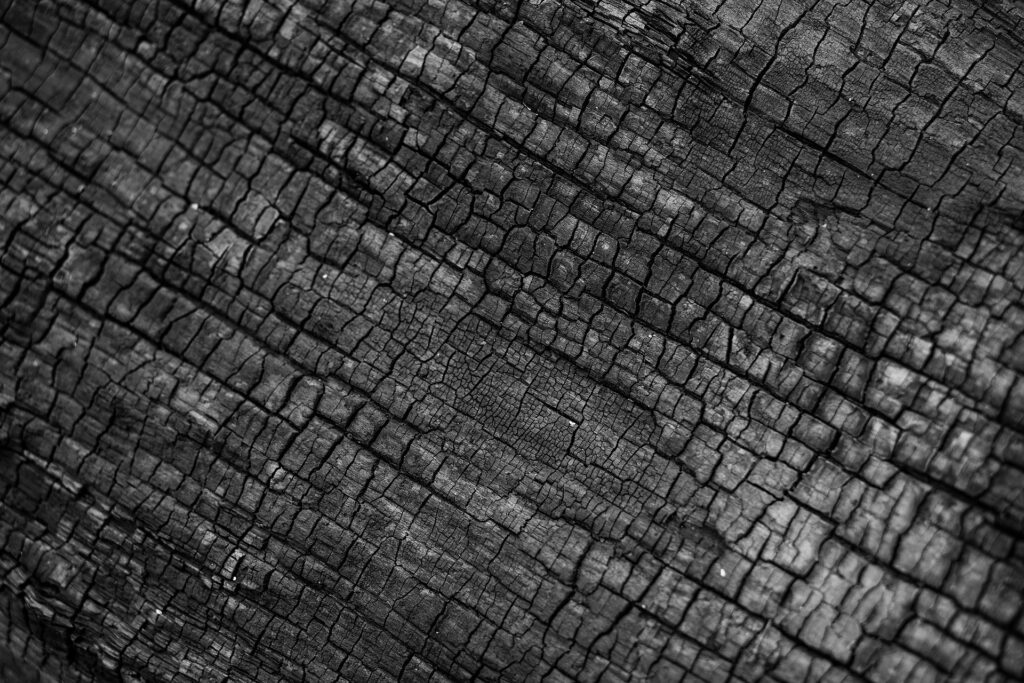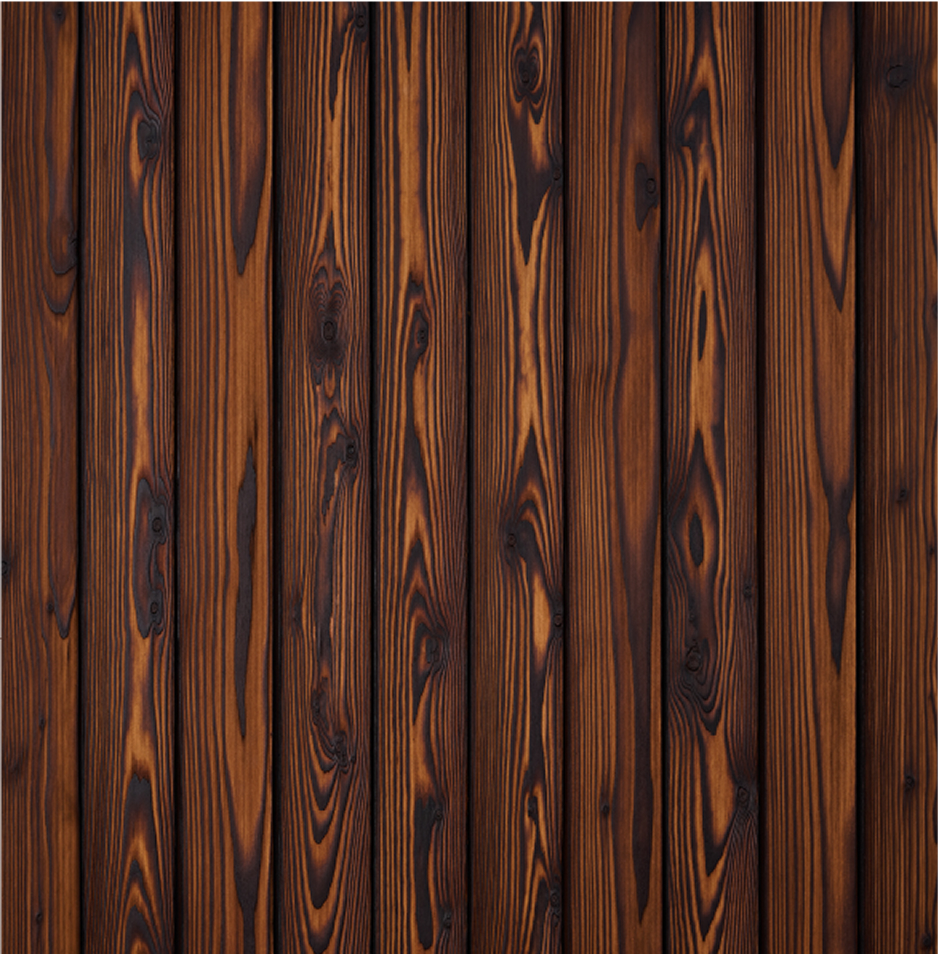Los Orígenes del Yakisugi
Yakisugi (焼杉), reconocida internacionalmente como Shou Sugi Ban, destaca como un método tradicional japonés que ha preservado la madera desde el siglo XVIII. Esta técnica se vincula estrechamente con el cedro japonés (Cryptomeria japonica) o sugi, mostrando una conexión profunda con el patrimonio y las prácticas japonesas.
Orígenes Históricos
- Era Edo (1603-1868): Se cree que Yakisugi se desarrolló durante la Era Edo, un período caracterizado por innovaciones en varias técnicas de construcción y carpintería. Fue una época donde la estética y la funcionalidad se unían, llevando al desarrollo de métodos que mejoraban la apariencia de la madera y sus propiedades físicas.
- Preservación de la Madera: El método se adoptó originalmente para proteger la madera contra los elementos, específicamente contra la humedad, insectos y la descomposición. El tratamiento con fuego crea una capa carbonizada en la superficie de la madera, que actúa como un escudo protector.
Método y Aplicación
- Proceso de Quemado: La técnica involucra quemar la superficie de la madera hasta que se forme una capa carbonizada. Esto se hace utilizando una antorcha o un método controlado de fuego que quema la superficie externa de la madera, sin comprometer su integridad estructural.
- Efecto Protector: La carbonización resultante protege la madera de manera efectiva contra la descomposición, insectos y, paradójicamente, fuego. La capa carbonizada es resistente al agua, lo que previene la pudrición y el desarrollo de hongos.
Significado Cultural y Estético
- Wabi-Sabi: La estética del Yakisugi está profundamente arraigada en la filosofía japonesa del wabi-sabi, que encuentra belleza en la imperfección y la transitoriedad. La superficie quemada de la madera refleja esta apreciación por la textura, color y la impermanencia, exhibiendo un aspecto único.
- Adaptación y Evolución: Aunque su uso inicial se debió principalmente a razones prácticas, la técnica ha evolucionado con el tiempo para incorporar también consideraciones estéticas. Arquitectos y diseñadores contemporáneos de todo el mundo han adoptado el Yakisugi por su singularidad visual, así como por sus cualidades de sostenibilidad.
Sustainability
- Ecológico:Hoy valoramos el Yakisugi no solo por su belleza y durabilidad, sino también por ser una opción ecológica. La técnica no requiere productos químicos conservantes, convirtiéndola en una elección sostenible para revestimientos y otros usos arquitectónicos.
Popularidad Global
- Difusión Internacional: La técnica ha trascendido sus raíces japonesas. Ha ganado popularidad en todo el mundo, especialmente en proyectos de arquitectura y diseño que valoran materiales naturales y sostenibilidad. Madera Carbonizada Yakisugi en España es cada vez más accesible.
La técnica Yakisugi es un testimonio de la ingeniosidad humana en armonía con la naturaleza. Su adopción y adaptación globales reflejan un creciente aprecio por la sostenibilidad, la belleza natural y los materiales que narran una historia rica y auténtica.
La Ciencia Detrás de la Belleza
La técnica de Yakisugi, que implica la carbonización deliberada de la superficie de la madera, es un proceso fascinante tanto desde una perspectiva científica como práctica. Esta metodología transforma la estética de la madera y sus propiedades físicas, confiriéndole una serie de beneficios duraderos y una belleza singular. Profundicemos en la ciencia detrás de esta técnica milenaria:
Creación de la Capa Protectora

- Carbonización Superficial: El proceso de Yakisugi implica quemar intencionalmente la capa externa de la madera hasta que se carboniza. Esta carbonización no penetra profundamente en la madera, sino que crea una capa superficial negra rica en carbono. Esta capa carbonizada actúa activamente como un escudo, proporcionando a la madera varias mejoras en su protección.
- Propiedades Repelentes: La superficie carbonizada es hidrofóbica, lo que significa que repele el agua. Esto reduce significativamente la absorción de humedad por la madera, minimizando la hinchazón, la contracción, y la posibilidad de pudrición y crecimiento de hongos. Además, la capa carbonizada es menos susceptible a la combustión, proporcionando una resistencia mejorada al fuego.
Mejora de Durabilidad y Resistencia
- Protección contra Plagas: La capa carbonizada repele activamente a los insectos y plagas que se alimentan habitualmente de la madera sin tratar. Los insectos tienden a evitar la madera tratada con Yakisugi debido a su superficie carbonizada, que es inhóspita para ellos.
- Longevidad Extendida: Al alterar la química de la superficie de la madera, el Yakisugi incrementa significativamente su vida útil. La capa carbonizada protege la madera interior, manteniéndola en un estado más preservado por períodos extendidos, incluso en condiciones ambientales adversas.
Realce Estético

- Textura y Color: La quema cuidadosa fortalece la madera y realza su textura y color. El proceso crea patrones únicos de carbonización en la superficie, dando a cada pieza de madera un aspecto distintivo. Puedes ajustar la profundidad de la quemadura para variar el acabado, desde un negro carbón hasta un gris, según la intensidad y duración del fuego que apliques.
- Carácter Único y Belleza Atemporal: La carbonización realza y preserva las variaciones naturales de cada pieza de madera tratada con Yakisugi, haciéndola única. Esta singularidad aporta un valor estético, reflejando una profunda conexión con la naturaleza y brindando una belleza atemporal apreciada en diversas formas de diseño y arquitectura contemporáneos.
La ciencia detrás de Yakisugi es un testimonio de cómo técnicas antiguas pueden tener aplicaciones modernas significativas, ofreciendo soluciones sostenibles y estéticamente atractivas para la preservación de la madera, creando proyectos como fachadas o revestimientos de madera quemada. La combinación de resistencia mejorada, durabilidad, y belleza singular hace de Yakisugi una opción valiosa en el mundo del diseño y la construcción sostenibles.
Yakisugi en la Actualidad
 Trascendiendo su papel tradicional, el Yakisugi hoy inspira a arquitectos y diseñadores en todo el mundo y la Madera Carbonizada Yakisugi se encuentra en España. Su aplicabilidad moderna es un testimonio de su versatilidad, resonando con la sabiduría ancestral mientras se adapta a las demandas estéticas y funcionales contemporáneas. Explora cómo Madera Carbonizada Yakisugi en España sigue influyendo en tendencias modernas en diseño sostenible y arquitectura innovadora.
Trascendiendo su papel tradicional, el Yakisugi hoy inspira a arquitectos y diseñadores en todo el mundo y la Madera Carbonizada Yakisugi se encuentra en España. Su aplicabilidad moderna es un testimonio de su versatilidad, resonando con la sabiduría ancestral mientras se adapta a las demandas estéticas y funcionales contemporáneas. Explora cómo Madera Carbonizada Yakisugi en España sigue influyendo en tendencias modernas en diseño sostenible y arquitectura innovadora.
Influencia en el Diseño Sostenible
- Sostenibilidad Ecológica: En un mundo donde la sostenibilidad se ha convertido en un imperativo, el Yakisugi resuena fuertemente debido a su enfoque ecológico. La técnica no requiere productos químicos o tratamientos sintéticos para preservar la madera, lo cual es una ventaja significativa en la construcción sostenible y el diseño ecológico. Este método natural aprovecha el poder del fuego para mejorar la longevidad y la resistencia de la madera, reduciendo la necesidad de mantenimiento y reemplazo.
- Reducción de la Huella de Carbono: Al prolongar la vida útil de la madera, el Yakisugi contribuye a la reducción del consumo de recursos y, por ende, a la disminución de la huella de carbono asociada con la producción y el procesamiento de nuevos materiales de construcción.
En cuanto a España, como en muchos otros países, la arquitectura y el diseño contemporáneos han estado adoptando técnicas y materiales sostenibles y ecológicos, entre los cuales se encuentra la madera quemada Yakisugi. Aunque no hay datos específicos que indiquen cuándo o en qué medida España ha adoptado esta técnica de carbonización, es razonable asumir que arquitectos, diseñadores y constructores en el país están explorando y utilizando Yakisugi, especialmente aquellos que se enfocan en la sostenibilidad, la innovación y la estética única que ofrece esta técnica.
Aplicaciones en Arquitectura Innovadora
- Versatilidad Estética: Los arquitectos y diseñadores modernos adoptan la madera carbonizada Yakisugi por sus beneficios prácticos y por su versatilidad estética. La textura carbonizada, la profundidad del color y la pátina única que proporciona esta técnica pueden complementar una variedad de estilos arquitectónicos, desde los más tradicionales hasta los contemporáneos y minimalistas.
- Integración con Tecnologías Modernas: A pesar de su antigüedad, podemos integrar perfectamente el Yakisugi con tecnologías constructivas modernas y materiales innovadores, creando soluciones de diseño que combinan vanguardia y una tradición probada por el tiempo.
Influencia en las Tendencias de Diseño
- Focalización en la Autenticidad: Existe una creciente tendencia hacia la autenticidad en el diseño y la arquitectura, con una apreciación renovada por los materiales que cuentan una historia o poseen un carácter distintivo. El Yakisugi ofrece, con su superficie rica en texturas y su patina que evoluciona con el tiempo, una expresión auténtica altamente valorada en el diseño contemporáneo.
- Adaptabilidad y Personalización: La técnica permite una gran adaptabilidad y personalización, ya que el grado de quemado puede ajustarse para crear diferentes acabados y efectos, lo que la hace atractiva para proyectos que requieren un toque personalizado o único.
En una era que valora la sostenibilidad, el Yakisugi emerge como un símbolo de equilibrio entre la conservación ambiental y la innovación estética. Este segmento destaca cómo la técnica apoya el uso consciente de recursos, fomentando la durabilidad y reduciendo la necesidad de mantenimiento, mientras ofrece una estética única que celebra las imperfecciones naturales de la madera.
¿Intrigado por la belleza y la resiliencia del Yakisugi? ¿Deseas explorar cómo esta técnica puede transformar tus espacios o proyectos? Descubre más sobre nuestro amor por la madera quemada y cómo puedes incorporar este arte atemporal en tu mundo. ¡Contáctanos hoy para explorar las posibilidades infinitas de la Madera Carbonizada Yakisugi en España.
La técnica de Yakisugi es más que un método de tratamiento de madera; es un legado que encapsula siglos de innovación, belleza y respeto por la naturaleza. Al abrazar esta tradición ancestral, invitamos una pieza de la historia y el arte japonés para enriquecer nuestras vidas modernas, permitiendo que la madera no solo cuente una historia, sino que también inspire a futuras generaciones a crear con conciencia, belleza y respeto por el ambiente.
Síguenos en las redes sociales para más insights sobre técnicas sostenibles e innovaciones en diseño.
Suministramos Madera Carbonizada Yakisugi en España.
@Zenwoodes

